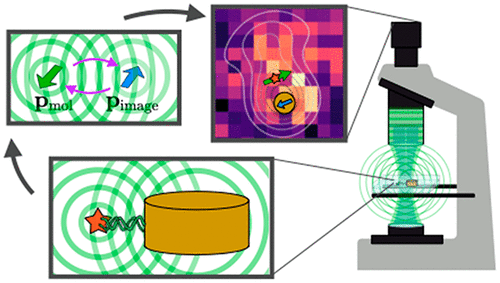当前位置:
X-MOL 学术
›
J. Phys. Chem. C
›
论文详情
Our official English website, www.x-mol.net, welcomes your
feedback! (Note: you will need to create a separate account there.)
Model-Based Insight into Single-Molecule Plasmonic Mislocalization
The Journal of Physical Chemistry C ( IF 3.3 ) Pub Date : 2021-11-02 , DOI: 10.1021/acs.jpcc.1c07989 Tiancheng Zuo 1 , Harrison J. Goldwyn 2 , David J. Masiello 2 , Julie S. Biteen 1
The Journal of Physical Chemistry C ( IF 3.3 ) Pub Date : 2021-11-02 , DOI: 10.1021/acs.jpcc.1c07989 Tiancheng Zuo 1 , Harrison J. Goldwyn 2 , David J. Masiello 2 , Julie S. Biteen 1
Affiliation

|
Noble metal nanoparticles act as visible-wavelength antennas that reshape the emission of nearby dye molecules. Because single-molecule imaging overcomes ensemble averaging, it is uniquely suited for understanding these plasmonic effects. We have engineered single-particle assemblies consisting of a gold nanodisk surrounded by ATTO590 dye molecules attached by double-stranded DNA linkers. These assemblies provide a controlled geometry that places plasmon-coupled dye molecules at specific radial positions in the plane of the nanodisk and provides the ground truth actual dye molecule position for further analysis. We modeled the molecule–nanoantenna interaction as two coupled dipoles and propagated their interfering fields through a diffraction-limited microscope to generate a coupled-dipole image that accurately recreates the distorted PSFs seen in numerical simulations of plasmon-enhanced single-molecule fluorescence. We fit simulated and experimental data to the model function as well as to a standard Gaussian function and evaluated the advantages of the model approach. Overall, we find that the image model can better recapture certain aspects of the dye molecule mislocalization, and we propose that remaining gaps can be addressed by integrating higher-order plasmon multipole effects into the nanodisk response as well as by simultaneously using both image and spectral information.
中文翻译:

基于模型的单分子等离子体错误定位
贵金属纳米粒子充当可见波长天线,重塑附近染料分子的发射。由于单分子成像克服了整体平均,它特别适合于理解这些等离子体效应。我们设计了单粒子组件,由金纳米盘组成,周围环绕着由双链 DNA 接头连接的 ATTO590 染料分子。这些组件提供了一种受控的几何形状,可将等离子体耦合染料分子放置在纳米盘平面中的特定径向位置,并提供真实的染料分子位置以供进一步分析。我们将分子-纳米天线相互作用建模为两个耦合偶极子,并通过衍射极限显微镜传播它们的干涉场,以生成耦合偶极子图像,该图像准确地再现了等离子体增强单分子荧光数值模拟中看到的扭曲 PSF。我们将模拟和实验数据拟合到模型函数以及标准高斯函数,并评估了模型方法的优势。总的来说,我们发现图像模型可以更好地重新捕捉染料分子错误定位的某些方面,我们建议可以通过将高阶等离子体多极效应集成到纳米盘响应中以及同时使用图像和光谱来解决剩余的间隙信息。我们将模拟和实验数据拟合到模型函数以及标准高斯函数,并评估了模型方法的优势。总的来说,我们发现图像模型可以更好地重新捕捉染料分子错误定位的某些方面,我们建议可以通过将高阶等离子体多极效应集成到纳米盘响应中以及同时使用图像和光谱来解决剩余的间隙信息。我们将模拟和实验数据拟合到模型函数以及标准高斯函数,并评估了模型方法的优势。总的来说,我们发现图像模型可以更好地重新捕捉染料分子错误定位的某些方面,我们建议可以通过将高阶等离子体多极效应集成到纳米盘响应中以及同时使用图像和光谱来解决剩余的间隙信息。
更新日期:2021-11-11
中文翻译:

基于模型的单分子等离子体错误定位
贵金属纳米粒子充当可见波长天线,重塑附近染料分子的发射。由于单分子成像克服了整体平均,它特别适合于理解这些等离子体效应。我们设计了单粒子组件,由金纳米盘组成,周围环绕着由双链 DNA 接头连接的 ATTO590 染料分子。这些组件提供了一种受控的几何形状,可将等离子体耦合染料分子放置在纳米盘平面中的特定径向位置,并提供真实的染料分子位置以供进一步分析。我们将分子-纳米天线相互作用建模为两个耦合偶极子,并通过衍射极限显微镜传播它们的干涉场,以生成耦合偶极子图像,该图像准确地再现了等离子体增强单分子荧光数值模拟中看到的扭曲 PSF。我们将模拟和实验数据拟合到模型函数以及标准高斯函数,并评估了模型方法的优势。总的来说,我们发现图像模型可以更好地重新捕捉染料分子错误定位的某些方面,我们建议可以通过将高阶等离子体多极效应集成到纳米盘响应中以及同时使用图像和光谱来解决剩余的间隙信息。我们将模拟和实验数据拟合到模型函数以及标准高斯函数,并评估了模型方法的优势。总的来说,我们发现图像模型可以更好地重新捕捉染料分子错误定位的某些方面,我们建议可以通过将高阶等离子体多极效应集成到纳米盘响应中以及同时使用图像和光谱来解决剩余的间隙信息。我们将模拟和实验数据拟合到模型函数以及标准高斯函数,并评估了模型方法的优势。总的来说,我们发现图像模型可以更好地重新捕捉染料分子错误定位的某些方面,我们建议可以通过将高阶等离子体多极效应集成到纳米盘响应中以及同时使用图像和光谱来解决剩余的间隙信息。













































 京公网安备 11010802027423号
京公网安备 11010802027423号